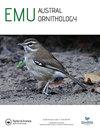Monitoring vocal activity and temporal patterns in attendance of White-chinned Petrels using bioacoustics
IF 1.1
4区 生物学
Q3 ORNITHOLOGY
引用次数: 0
Abstract
ABSTRACT Monitoring of population sizes and trends using conventional surveys is challenging for nocturnal, burrow-nesting seabirds. The White-chinned Petrel is the most commonly killed species in Southern Ocean fisheries and its breeding success at many sites is reduced because of predation by invasive cats and rodents. As adaptive management of such threats requires cost-effective and reproducible protocols for monitoring populations, we examined the potential of automated bioacoustic techniques for measuring colony attendance patterns (relative number of birds visiting at a given time) using data from acoustic recorders deployed over a breeding season at Bird Island, South Georgia. Generic recognition software was of limited utility, but a suite of acoustic indices in a random forest model reliably predicted the occurrence of vocalisations. Vocal activity showed clear temporal patterns, despite high day-to-day variability, and was lowest during the pre-laying period, in the early evening, and on moonlit nights. To facilitate estimation of population density using acoustic recorders, we determined the mean vocalisation rate of individuals (2.3 min−1), mean call length (~15.3 sec), and detection distance (~15 m based on signal to noise ratios of playbacks). Our results indicate that acoustic indices are a useful measure of colony attendance. If these indices can be linked to density, acoustic monitoring would provide a powerful and cost-effective census method for White-chinned Petrels and other nocturnal species.利用生物声学技术监测白下巴海燕的发声活动和时间模式
对夜间活动、穴居的海鸟来说,使用常规调查来监测种群规模和趋势是具有挑战性的。白下巴海燕是南大洋渔业中最常被杀死的物种,由于入侵猫和啮齿动物的捕食,它在许多地方的繁殖成功率降低。由于这种威胁的适应性管理需要具有成本效益和可复制的种群监测协议,我们研究了自动化生物声学技术的潜力,利用部署在南乔治亚鸟岛繁殖季节的声学记录仪的数据来测量种群的出诊模式(给定时间内来访的鸟类的相对数量)。通用识别软件的效用有限,但随机森林模型中的一套声学指数可靠地预测了发声的发生。尽管每天都有很大的变化,但声音活动表现出清晰的时间模式,在产卵前、傍晚和月光下的夜晚,声音活动最低。为了便于使用声学记录器估计种群密度,我们确定了个体的平均发声率(2.3 min−1),平均呼叫长度(~15.3秒)和检测距离(基于回放的信噪比~15米)。我们的结果表明,声学指标是一个有用的衡量蜂群出席。如果这些指标能够与密度联系起来,声学监测将为白颌海燕和其他夜行物种提供一种有效而经济的普查方法。
本文章由计算机程序翻译,如有差异,请以英文原文为准。
求助全文
约1分钟内获得全文
求助全文
来源期刊

Emu-Austral Ornithology
生物-鸟类学
CiteScore
2.00
自引率
7.70%
发文量
33
审稿时长
>12 weeks
期刊介绍:
Emu – Austral Ornithology is the premier journal for ornithological research and reviews related to the Southern Hemisphere and adjacent tropics. The journal has a long and proud tradition of publishing articles on many aspects of the biology of birds, particularly their conservation and management.
 求助内容:
求助内容: 应助结果提醒方式:
应助结果提醒方式:


